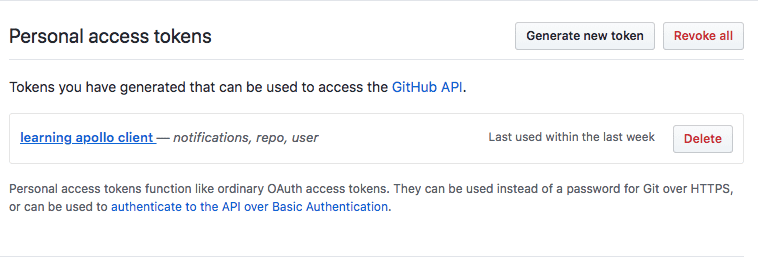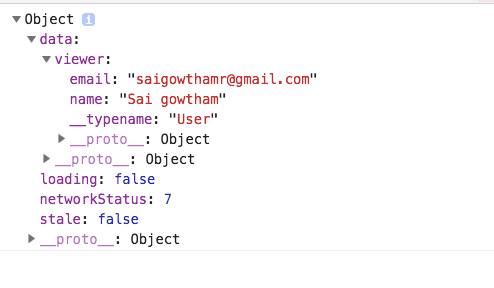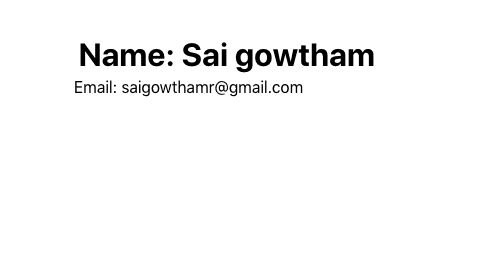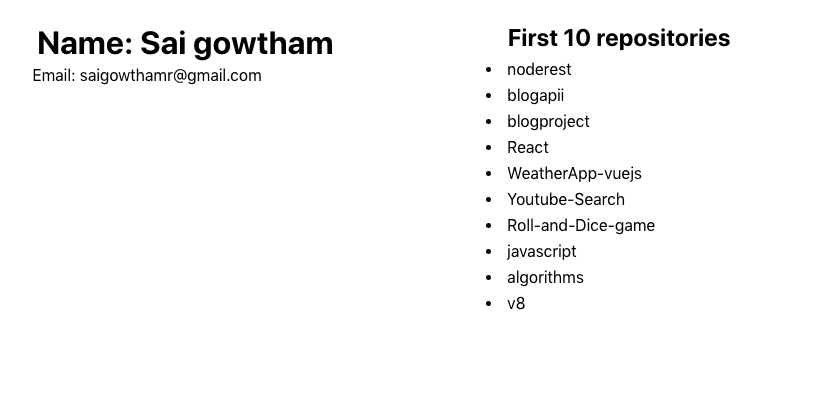A beginners Guide to React Apollo client tutorial
In this tutorial, we will learn about how to fetch and update the data from the GraphQL API in react apps by using the Apollo client.
We are using the GitHub GraphQL API for learning purposes.
Note : if you stuck anywhere in this tutorial, then please refer to the final code repository on GitHub
Setup the react app
Let’s set up the react app by using the create-react-app.
npx create-react-app react-apolloThe above command will download the required files in the “react-apollo” folder to start the react app.
change your working directory to “react-apollo”.
cd react-apollo
npm startnpm start command is used to start the local development server.
Now we need to install the Apollo client packages.
Installing apollo client packages
npm install apollo-boost react-apollo graphqlThis above command will download the three packages which are apollo-boost,react-apollo and graphql.
Connecting with GitHub graphql API
Open your GitHub account and navigate to settings then click on developer settings and generate personal access token by selecting the fields.
Note: copy the personal access token and save it in your pc because the token is only visible once.
Now open your index.js file in your react app and add the below code with your personal access token.
import React from 'react';
import { render } from 'react-dom';
import './index.css';
import App from './App';
import ApolloClient from "apollo-boost";
const client = new ApolloClient({
uri: "https://api.github.com/graphql",
request: operation => {
operation.setContext({
headers: {
authorization: `Bearer your-personal-access-token`
},
});
}
});
render(<App />, document.getElementById('root'));Here we import an ApolloClient constructor from the apollo-boost package and instantiate the client.
uri: The graphql endpoint we are using to fetch the data.
request: For every request, we are sending the authorization header to verify the present user.
let’s test our code by running a query.
In GrapQL, Query means to get the data from the API and Mutation means to update or delete or add data.
import React from "react";
import { render } from "react-dom";
import "./index.css";
import App from "./App";
import ApolloClient, { gql } from "apollo-boost";
const client = new ApolloClient({
uri: "https://api.github.com/graphql",
request: operation => {
operation.setContext({
headers: {
authorization: `Bearer your-personal-access-token`
}
});
}
});
client
.query({
query: gql`
query GetnameandEmail {
viewer {
email
name
}
}
`
})
.then(res => console.log(res));
render(<App />, document.getElementById("root"));
Open your console and you will see an object with your name and email id.
First, we imported the gql tag from the apollo-client package then we invoked the client.query method by passing our query and logged the response in the console.
Connect the Client to React
Instead of the logging the data in the console we are connecting the client to the React.
We need to wrap our <App/> component with the ApolloProvider component provided by the apollo-boost package its is similar to the react-context provider which allows accessing the client anywhere from our app.
import React from "react";
import { render } from "react-dom";
import "./index.css";
import App from "./App";
import ApolloClient, { gql } from "apollo-boost";
import { ApolloProvider } from "react-apollo";
const client = new ApolloClient({
uri: "https://api.github.com/graphql",
request: operation => {
operation.setContext({
headers: {
authorization: `Bearer your-personal-access-token`
}
});
}
});
render(
<ApolloProvider client={client}>
<App />
</ApolloProvider>,
document.getElementById("root")
);Fetching the data from the Components
React apollo provides us a Query component which is used to fetch the data straight from the components.
The Query component takes the query as a prop inside the Query component we need to define a function with a parameter so that we can access the result of this query from this parameter which is passed by the Query component.
A parameter is an object which contains three properties loading, error, data.
loading: it is true if the request is still in process.
error: it contains error related data in case if the request is failed.
data: The result of the query is available in this property.
Open your app.js file and add the following data.
import React, { Component } from "react";
import "./App.css";
import { Query } from "react-apollo";
import { gql } from "apollo-boost";
const query = gql`
{
viewer {
name
email
}
}
`;
class App extends Component {
render() {
return (
<div className="App">
<Query query={query}>
{result => {
if (result.loading) return <p>loading...</p>;
if (result.error) return <p>{result.error.message}</p>;
return (
<div>
<h1>Name: {result.data.viewer.name}</h1>
<p>Email: {result.data.viewer.email}</p>
</div>
);
}}
</Query>
</div>
);
}
}
export default App;
Now we can see the Name and email is rendered on the screen.
Apollo client devtools
Let’s install Apollo client dev tools from the chrome web store.
Once you successfully installed we can access the GraphiQL playground from the dev tools tab. By using GraphiQL playground we can send queries and mutations to the server.
Now open your chrome dev tools and click on apollo tab you will see a GraphiQL playground.
The left side data on the image is the query and right side data is the result.
Passing arguments to the Queries
We can also filter the queries by passing the arguments.
create a new file called my-repostiories.js in your src folder and add the following code.
import React, { Component } from "react";
import { Query } from "react-apollo";
import { gql } from "apollo-boost";
const reposQuery = gql`
{
viewer {
repositories(first: 10) {
edges {
node {
name
}
}
}
}
}
`;
class Myrepositories extends Component {
render() {
return (
<Query query={reposQuery}>
{({ data, loading, error }) => {
if (loading) return <p>loading...</p>;
if (error) return <p>{error.message}</p>;
return (
<ul>
<h2>First 10 repositories</h2>
{data.viewer.repositories.edges.map(({ node }) => (
<li key={node.name}>{node.name}</li>
))}
</ul>
);
}}
</Query>
);
}
}
export default Myrepositories;
In the above code, we first created a reposQuery by passing an argument first:10 so that we can only get first 10 repositories.
Passing arguments using Query variables
So far we are passing the static values to the arguments let’s replace the static values with the dynamic values by using query variables.
const reposQuery = gql`
query Myrepositories($first:Int!){
viewer {
repositories(first: $first) {
edges {
node {
name
}
}
}
}
}`The query variable names are always preceding by a $ character.
The static value is replaced by a $first variable name so that we can pass the value to query dynamically by using a $first variable.
import React, { Component } from "react";
import { Query } from "react-apollo";
import { gql } from "apollo-boost";
const reposQuery = gql`
query Myrepositories($first: Int!) {
viewer {
repositories(first: $first) {
edges {
node {
name
}
}
}
}
}
`;
class Myrepositories extends Component {
render() {
return (
<Query query={reposQuery} variables={{ first: 10 }}>
{({ data, loading, error }) => {
if (loading) return <p>loading...</p>;
if (error) return <p>{error.message}</p>;
return (
<div>
<ul>
<h2>First 10 repositories</h2>
{data.viewer.repositories.edges.map(({ node }) => (
<li key={node.name}>{node.name}</li>
))}
</ul>
</div>
);
}}
</Query>
);
}
}
export default Myrepositories;
The Query Component has prop variables object containing the variable we want to pass to our GraphQL query.
Fetch more data
Let’s add a Load more button inside our Myrepositories component which helps us to fetch the more
repositories from the GitHub.
We are using the fecthMore function provided by the Query Component to load the more data.
<Query query={reposQuery} variables={{ first: 10 }}>
{({ data, loading, error, fetchMore }) => {
if (loading) return <p>loading...</p>;
if (error) return <p>{error.message}</p>;
let current = data.viewer.repositories.edges.length;
return (
<div>
<ul>
<h2>First {current}repositories</h2>
{data.viewer.repositories.edges.map(({ node }) => (
<li key={node.name}>{node.name}</li>
))}
</ul>
<button
onClick={() => {
fetchMore({
variables: { first: current + 10 },
updateQuery: (prev, { fetchMoreResult }) => {
if (!fetchMoreResult) {
return prev;
}
return Object.assign(prev, fetchMoreResult);
}
});
}}
>
Load more
</button>
</div>
);
}}
</Query>;
The fetchMore function takes the object with two properties variables and updateQuery.
variables: The variables we need to pass to the GraphQL query.
updateQuery: The updateQuery function is used to merge the data with the new data and re-render the component with the updated data.
Let’s refactor the above code by creating a handleMore method.
import React, { Component } from "react";
import { Query } from "react-apollo";
import { gql } from "apollo-boost";
const reposQuery = gql`
query Myrepositories($first: Int!) {
viewer {
repositories(first: $first) {
edges {
node {
name
}
}
}
}
}
`;
class Myrepositories extends Component {
handleMore = (data, fetchMore, current) => {
fetchMore({
variables: { first: current + 10 },
updateQuery: (prev, { fetchMoreResult }) => {
if (!fetchMoreResult) {
return prev;
}
return Object.assign(prev, fetchMoreResult);
}
});
};
render() {
return (
<Query query={reposQuery} variables={{ first: 10 }}>
{({ data, loading, error, fetchMore }) => {
if (loading) return <p>loading...</p>;
if (error) return <p>{error.message}</p>;
let current = data.viewer.repositories.edges.length;
return (
<div>
<ul>
<h2>First {current} repositories</h2>
{data.viewer.repositories.edges.map(({ node }) => (
<li key={node.name}>{node.name}</li>
))}
</ul>
<button onClick={() => this.handleMore(data, fetchMore, current)}>
Load more
</button>
</div>
);
}}
</Query>
);
}
}
export default Myrepositories;
It’s time to test does our Load more button.
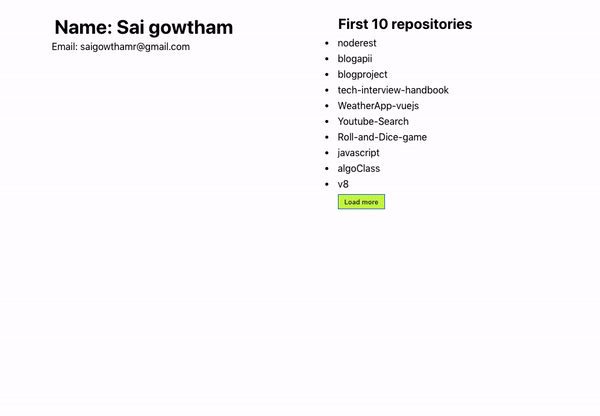
Code refactoring
If you look into Myrepositories component it’s already getting big so that first we are removing all queries from the React components and place in the separate file called queries.js.
import { gql } from 'apollo-boost'
const reposQuery = gql`
query Myrepositories($first:Int!){
viewer {
repositories(first: $first) {
edges {
node {
id
name
stargazers{
totalCount
}
viewerHasStarred
}
}
}
}
}
`
const userQuery = gql` {
viewer {
name
email
}
}`
export { reposQuery, userQuery }Now we can import the required queries from this queries.js file.
Let’s create a new file called display-repos.js and add the below code.
import React from 'react';
function Displayrepos(props) {
const { current, data, refetch } = props
return (
<div>
<h2>First {current} repositories</h2>
{data.viewer.repositories
.edges.map(({ node }) =>
<ul className="list" key={node.id}>
<li>{node.name}</li>
<li>stars {node.stargazers.totalCount}</li>
</ul>
)}
<button onClick={props.handleMore}>Load more</button>
</div>
)
}
export default Displayrepos;Update the Myrepositories component by adding a Displayrepos child component.
import React, { Component } from "react";
import { Query } from "react-apollo";
import Displayrepos from "./display-repos";
import { reposQuery } from "./queries";
class Myrepositories extends Component {
handleMore = (data, fetchMore, current) => {
fetchMore({
variables: { first: current + 10 },
updateQuery: (prev, { fetchMoreResult }) => {
if (!fetchMoreResult) {
return prev;
}
return Object.assign(prev, fetchMoreResult);
}
});
};
render() {
return (
<Query query={reposQuery} variables={{ first: 10 }}>
{({ data, loading, error, fetchMore, refetch }) => {
if (loading) return <p>loading...</p>;
if (error) return <p>{error.message}</p>;
let current = data.viewer.repositories.edges.length;
return (
<Displayrepos
current={current}
refetch={refetch}
data={data}
handleMore={() => this.handleMore(data, fetchMore, current)}
/>
);
}}
</Query>
);
}
}
export default Myrepositories;
Mutations
To modify the data in graphql we need to send mutations instead of queries because queries are used to get the data from the backend.
Mutations purpose is to add or remove or update the data that’s currently stored in the backend.
Mutations start with a keyword mutation.
Example for the adding a star to your GitHub repository.
mutation AddStar($repoid:ID!){
addStar(input:{starrableId:$repoid}){
starrable{
stargazers{
totalCount
}
viewerHasStarred
}
}
}once the mutation is completed it returns the data back from the backend.
the output from the backend
{
"data": {
"addStar": {
"starrable": {
"stargazers": {
"totalCount": 1
},
"viewerHasStarred": true
}
}
}
}Let’s create a new file called addstar.js.
Now we are implementing the Addstar component which helps us to add the star to your repositories.
React apollo package is also Provides the Mutation component which is used to send the mutations to the graphql api.
In the Mutation component, we need to pass the function as children it’s also using render props pattern same as the Queries component.
The first parameter of the function is the mutate function and a second parameter is an object containing the data from the backend.
import React, { Component } from "react";
import { Mutation } from "react-apollo";
import { gql } from "apollo-boost";
const addStarquery = gql`
mutation AddStar($repoid: ID!) {
addStar(input: { starrableId: $repoid }) {
starrable {
stargazers {
totalCount
}
viewerHasStarred
}
}
}
`;
class AddStar extends Component {
render() {
return (
<Mutation mutation={addStarquery}>
{(addStar, { data, loading, error }) => {
return (
<div>
<button
onClick={() => {
addStar({ variables: { repoid: this.props.id } }).then(
res => {
this.props.refetch();
}
);
}}
>
{" "}
Addstar
</button>
{loading && <p>loading...</p>}
{error && <p>{error.message}</p>}
</div>
);
}}
</Mutation>
);
}
}
export default AddStar;
The Mutation component takes the mutations as a mutation prop once the addStar mutation is finished we are chained it with then method and invoking the refetch method so that we can see the updated data in the UI.
Let’s create a new component called RemoveStar which is used to remove the star.
import React, { Component } from "react";
import { Mutation } from "react-apollo";
import { gql } from "apollo-boost";
const removeStarquery = gql`
mutation RemoveStar($repoid: ID!) {
removeStar(input: { starrableId: $repoid }) {
starrable {
stargazers {
totalCount
}
viewerHasStarred
}
}
}
`;
class RemoveStar extends Component {
render() {
return (
<Mutation mutation={removeStarquery}>
{(removeStar, { data, loading, error }) => {
return (
<div>
<button
onClick={() => {
removeStar({
variables: { repoid: this.props.id }
}).then(res => {
this.props.refetch();
});
}}
>
{" "}
remove star
</button>
{loading && <p>processing...</p>}
{error && <p>{error.message}</p>}
</div>
);
}}
</Mutation>
);
}
}
export default RemoveStar;
In the RemoveStar component we are invoking the removeStar mutation by passing
the variables repository id.
Update the display-repos.js file with the below code.
import React from "react";
import AddStar from "./addstar";
import RemoveStar from "./removestar";
function Displayrepos(props) {
const { current, data, refetch } = props;
return (
<div>
<h2>First {current} repositories</h2>
{data.viewer.repositories.edges.map(({ node }) => (
<ul className="list" key={node.id}>
<li>
{node.name}
{node.viewerHasStarred ? (
<RemoveStar id={node.id} refetch={refetch} />
) : (
<AddStar id={node.id} refetch={refetch} />
)}
</li>
<li>stars {node.stargazers.totalCount}</li>
</ul>
))}
<button onClick={props.handleMore}>Load more</button>
</div>
);
}
export default Displayrepos;In the above code first, we imported the AddStar and RemoveStar components then we added to our
component to render conditionally it means if you already added a star to your repository, we only render the RemoveStar component otherwise we render the AddStar component.
Let’s test it now.
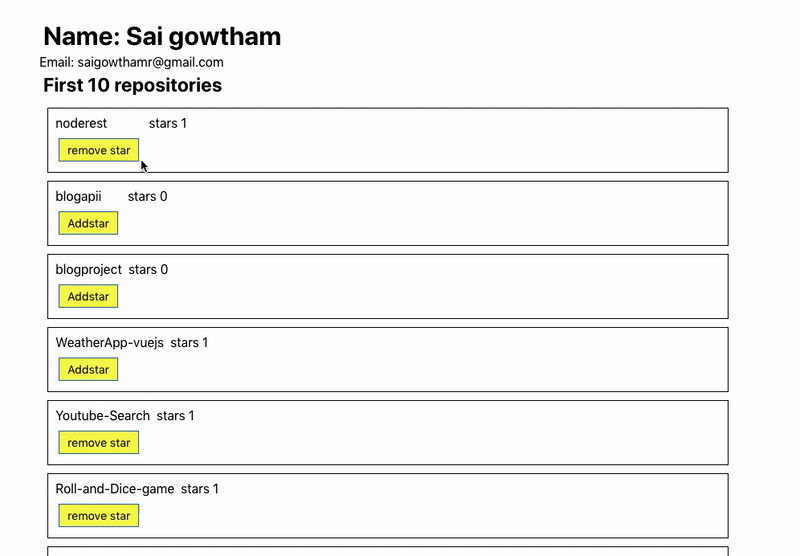
Have you seen in the above image our UI is updated if we add or remove a star?
Search bar
The Final app contains a search bar to search the public GitHub repositories.

